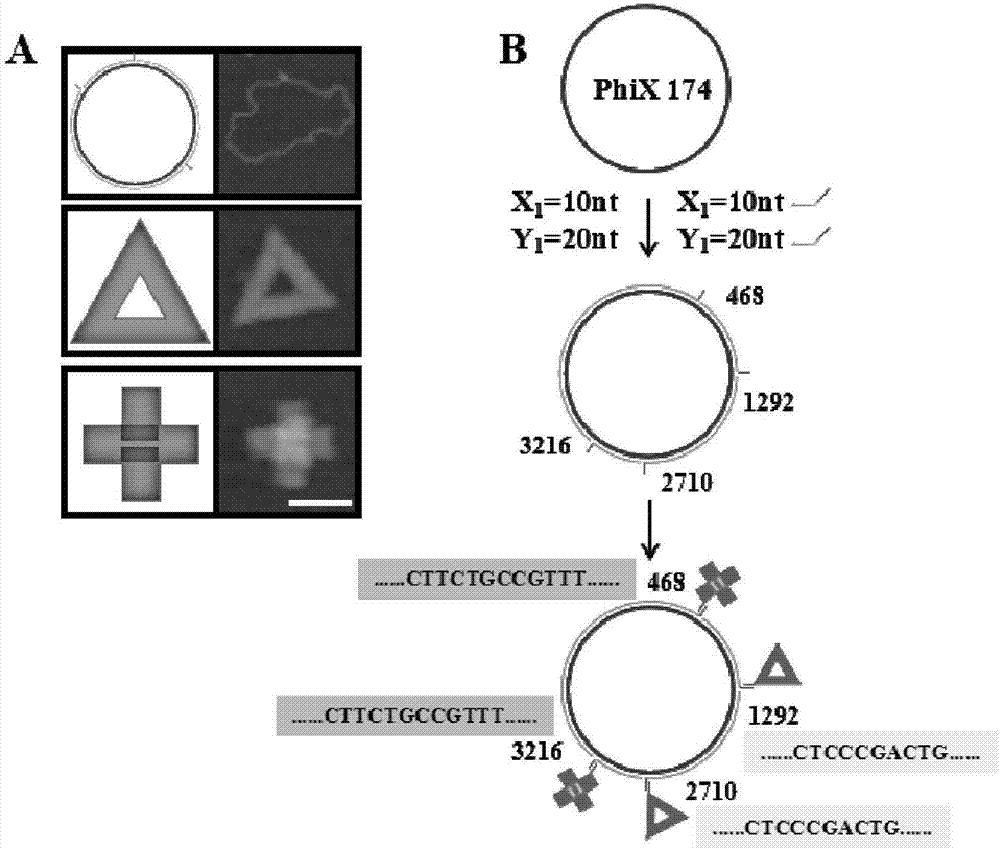Nanoprobe used for specific recognition of DNA sequences, and application method thereof
A DNA sequence and application method technology, applied in the field of detection analysis and molecular biology, can solve the problem of limited resolution optical diffraction limit and so on
- Summary
- Abstract
- Description
- Claims
- Application Information
AI Technical Summary
Problems solved by technology
Method used
Image
Examples
Embodiment 1
[0041] This embodiment is about the establishment of a closed circular single-stranded PhiX 174DNA model with diblock primers of different lengths, and its specific operations are as follows:
[0042] (1) figure 1 A in A is the constructed diblock primer, the Primer part binds to the specific site of the target DNA and effectively extends, the Capturer part hybridizes with the DNA origami probe, and is connected by a small single strand of the Spacer part in the middle. The sequence length of the fixed Capturer part is 20nt (Y=20nt), and the sequence length of the Primer part is set to 20nt, 17nt, 14nt, 12nt, 10nt, 8nt, 6nt (X=20nt, 17nt, 14nt, 12nt, 10nt, 8nt, 6nt), to explore the extension effect of primers of different lengths on PhiX 174DNA. In a 30 μL reaction system, 6 μL of PhiX 174 template strand, Vent(exo - ) enzyme 0.8 μL, 10×ThermoPol buffer 3 μL, diblock primer (10 μM) 2 μL, dNT mixture (2.5 mM) 2 μL, ultrapure water 16.2 μL. well mixed.
[0043] (2) Place the...
Embodiment 2
[0048] This embodiment is about the design and preparation of triangular and cross-shaped DNA origami probes, and its specific operations are:
[0049] (1) Mix M13mp18 bacteriophage circular single-stranded DNA, more than 100 unmodified staple strands, and staple strands with end-modified capture strands at a molar ratio of 1:10:10, that is, the added volumes are 2.5 μL, 5 μL, 5 μL, then 10 μL 10×TAE-Mg 2+ Buffer (Mg 2+ Concentration 12.5mol / L), supplemented with ultrapure water to a final volume of 100 μL, shake well.
[0050] (2) Place the mixed solution in step (1) in a PCR instrument and anneal at a rate of 0.1°C / 10s from 95°C to 20°C. After the reaction, use a 100kDa ultrafiltration tube to centrifuge to remove excess staple chains or pass through agar The sugar was purified by electrophoresis, concentrated and recovered using Freeze'N Squeeze DNA Gel Extraction Spin Columns, and stored at 4°C for use.
[0051] Among them, for the triA65, triB65, and triC65 end-modifie...
Embodiment 3
[0053] This example is about the specific labeling of the DNA origami probe to the same gene fragment of PhiX 174 and the high-resolution labeling at close range. The specific operations are as follows:
[0054] (1) Mix excess DNA origami probes with target DNA molecules labeled with specific diblock primers, place them in a closed foam box filled with 2L of water at 45°C, and react with natural cooling for more than 12 hours. From the extension of diblock primers to the labeling of origami probes, such as figure 2 Shown in B.
[0055] (2) The product obtained in step (1) is diluted to a certain number of times and observed under an atomic force microscope. Drop 3 μL of the sample on the newly peeled mica sheet, let it stand for adsorption for about 3 minutes, blow it dry with nitrogen gas, and observe it under the gas phase condition of multi-mode 8 AFM (NanoScope 5 controller, Bruker Company).
[0056] (3) For the close-range high-resolution markers of 3427 and 3460, 1900...
PUM
 Login to View More
Login to View More Abstract
Description
Claims
Application Information
 Login to View More
Login to View More - R&D
- Intellectual Property
- Life Sciences
- Materials
- Tech Scout
- Unparalleled Data Quality
- Higher Quality Content
- 60% Fewer Hallucinations
Browse by: Latest US Patents, China's latest patents, Technical Efficacy Thesaurus, Application Domain, Technology Topic, Popular Technical Reports.
© 2025 PatSnap. All rights reserved.Legal|Privacy policy|Modern Slavery Act Transparency Statement|Sitemap|About US| Contact US: help@patsnap.com



